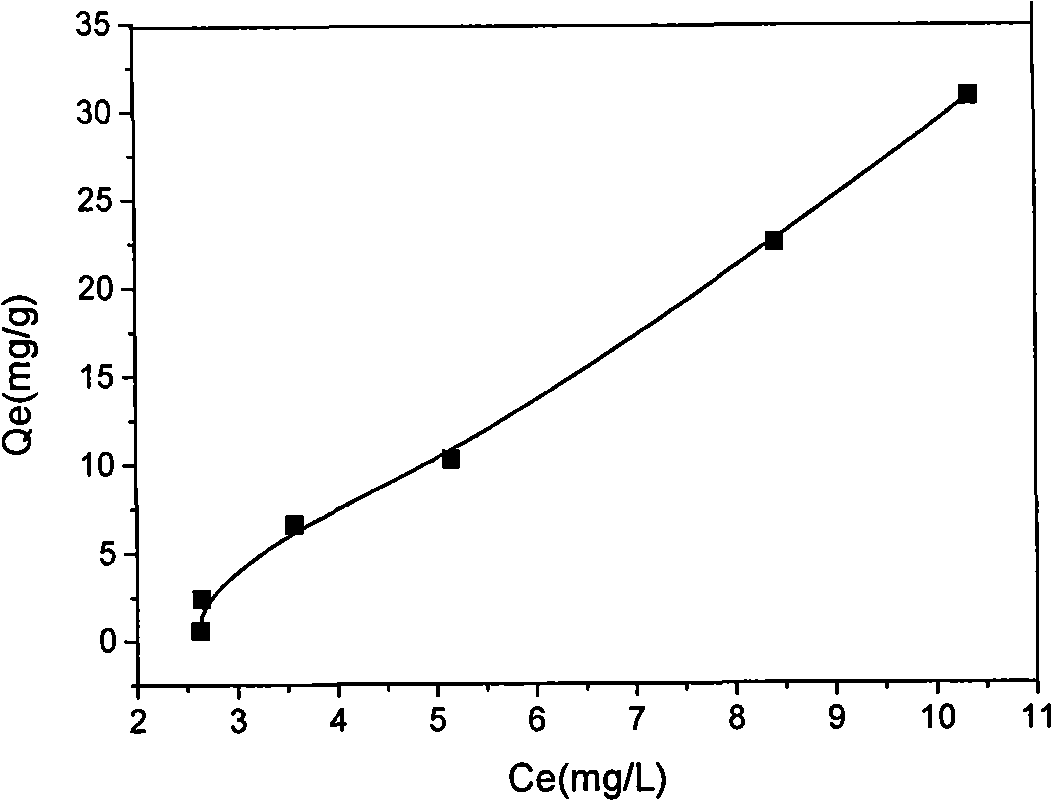Anionic surfactant intercalation titanium-based hydrotalcite and preparation thereof
A surfactant and anionic technology, which is applied in the field of titanium-based multifunctional organic-inorganic hybrid materials, can solve the problem of no anionic surfactant intercalation titanium-based hydrotalcite research, and no non-urea co-precipitation method. Titanium-based hydrotalcite and other problems, to achieve the effect of good adsorption effect and high application value
- Summary
- Abstract
- Description
- Claims
- Application Information
AI Technical Summary
Problems solved by technology
Method used
Image
Examples
Embodiment 1
[0026] 1. Dissolve sodium dodecylbenzenesulfonate (DBS-Na) (0.009mol, 3.1365g) in 120mL of deCO 2 Solution A was prepared in deionized water, Ni(NO 3 ) 2 ·6H 2 O (0.01266mol, 3.6815g) and TiCl 4 (0.5mL, 0.00422mol, while adding 2.0mL of hydrochloric acid to prevent TiCl 4 Hydrolysis) solution was dissolved in 70mL of deCO 2 Mixed salt solution B was prepared in deionized water, and NaOH (0.15mol, 6g) was dissolved in 300mL of deCO 2 In deionized water, make alkaline solution C.
[0027] 2. First put solution A into a 500mL four-necked bottle, at 35°C, under N 2Under protection and stirring conditions, the mixed salt solution B and alkali solution C were slowly added dropwise to solution A at the same time, the dropping rate was 2.33mL / min, the pH of the solution was always kept at 7.6 during the dropping process, and the dropping time was 30 minutes.
[0028] 3. After the dropwise addition, the solution was 2 Crystallization at 80°C under protection for 24 hours, then ...
Embodiment 2
[0031] 1. Dissolve DBS-Na (0.011mol, 3.8306g) in 180mL of deCO 2 Solution A was prepared in deionized water, Ni(NO 3 ) 2 ·6H 2 O (0.02532mol, 7.3643g) and TiCl 4 (containing 2.0mL of hydrochloric acid, 0.5mL of TiCl 4 , 0.00422mol) solution dissolved in 70mL of deCO 2 Mixed salt solution B was prepared in deionized water, and NaOH (0.15mol, 6g) was dissolved in 300mL of deCO 2 In deionized water, make alkaline solution C.
[0032] 2. First put solution A into a 500mL four-neck bottle, at 55°C, under N 2 Under protection and stirring conditions, the mixed salt solution B and alkali solution C were slowly added dropwise to solution A at the same time, the dropping rate was 1.17mL / min, the pH of the solution was always kept at 7.6 during the dropping process, and the dropping time was 1 hour.
[0033] 3. After the dropwise addition, the solution was 2 Crystallize at 80°C for 72 hours under protection, then cool to room temperature, transfer the mixture to a centrifuge tub...
Embodiment 3
[0036] 1. Dissolve DBS-Na (0.018mol, 6.273g) in 150mL of deCO 2 Solution A was prepared in deionized water, Ni(NO 3 ) 2 ·6H 2 O (0.042mol, 12.21g) and TiCl 4 (Containing 3.2mL of hydrochloric acid, 1.0mL of TiCl 4 , 0.00844mol) solution was dissolved in 70mL of deCO 2 Mixed salt solution B was prepared in deionized water, and NaOH (0.3mol, 12g) was dissolved in 300mL of deCO 2 In deionized water, make alkaline solution C.
[0037] 2. First put solution A into a 500mL four-necked bottle, at 35°C, under N 2 Under protection and stirring conditions, the mixed salt solution B and alkali solution C were slowly added dropwise to solution A at the same time, the dropping rate was 0.78mL / min, the pH of the solution was always kept at 8.2 during the dropping process, and the dropping time was 1.5 hours.
[0038] 3. After the dropwise addition, the solution was 2 Crystallize at 60°C under protection for 24 hours, then cool to room temperature, centrifuge at 2000 rpm for 10 minut...
PUM
 Login to View More
Login to View More Abstract
Description
Claims
Application Information
 Login to View More
Login to View More - R&D
- Intellectual Property
- Life Sciences
- Materials
- Tech Scout
- Unparalleled Data Quality
- Higher Quality Content
- 60% Fewer Hallucinations
Browse by: Latest US Patents, China's latest patents, Technical Efficacy Thesaurus, Application Domain, Technology Topic, Popular Technical Reports.
© 2025 PatSnap. All rights reserved.Legal|Privacy policy|Modern Slavery Act Transparency Statement|Sitemap|About US| Contact US: help@patsnap.com



